| Back to Back Issues Page |
 |
|
Dallying In The Dirt, Issue #117 --- Downy mildew seems to be the culprit in the Impatiens wilt mys September 01, 2012 |
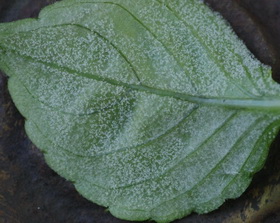
Plasmopara obducens doesn’t sound like somebody you would want to invite for dinner and truly it is not. I talked in the last issue about the rapid decline and death of Impatiens. My original thought was a bacterial infection but greater research and discussion with colleagues would seem to confirm the presence of a Downy Mildew, Plasmopara obducens, that is very specific to Impatiens walleriana, the common garden Impatiens that we all grow in great quantity. It spreads rapidly by wind or water splash and is totally fatal to any infected plants. It is being reported in ever increasing numbers, particularly in the Eastern half of N. America. Trying to treat infected plants is basically a waste of time and energy. It is similar to but not truly a fungus and therefore many common fungicides are ineffective and, at least in Canada, most of those chemicals are not available. Clean up and discard all infected plants and do not plant Impatiens in that location for a few years. Plasmopara produces two types of spores and one of them lives in the soil for a couple of years. If you are growing in containers, you could replace the soil but that will not stop the air borne spores from finding their way onto your plants. The underside of infected leaves will be covered in tiny white dots that are the fruiting bodies of this pathogen. It will be interesting to see if the massive market for Impatiens will rapidly disappear as both producers and consumers try to avoid having their crops suffer rapid and complete collapse. 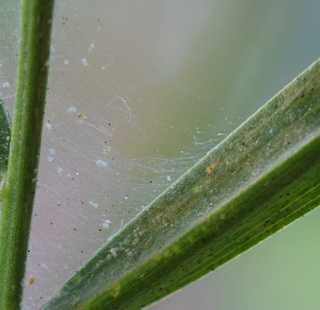 I’m not sure what I will do with this plant in the fall. Last year I tried to overwinter one indoors and I wound up throwing it out midwinter because it had become a huge spider mite breeding farm. If I bring it in this year, I will make sure that it has undergone the significant spray program that all of my part time houseplants receive, for a couple of weeks before they come in. Those nasty little mites are very prolific and have a four day life cycle. That means spraying them every two or three days for a couple of week to make sure you kill all the adults and the newly hatched nymphs before they get a chance to mature and lay the next batch of eggs. I have my lovely dwarf date palm outside on the deck, getting a similar treatment. It was supposed to be a full time houseplant until I discovered the webbing and wildlife on it a couple of weeks ago.
I’m not sure what I will do with this plant in the fall. Last year I tried to overwinter one indoors and I wound up throwing it out midwinter because it had become a huge spider mite breeding farm. If I bring it in this year, I will make sure that it has undergone the significant spray program that all of my part time houseplants receive, for a couple of weeks before they come in. Those nasty little mites are very prolific and have a four day life cycle. That means spraying them every two or three days for a couple of week to make sure you kill all the adults and the newly hatched nymphs before they get a chance to mature and lay the next batch of eggs. I have my lovely dwarf date palm outside on the deck, getting a similar treatment. It was supposed to be a full time houseplant until I discovered the webbing and wildlife on it a couple of weeks ago.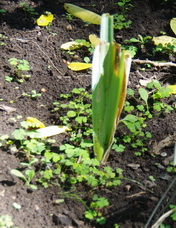 My major renovation of the two big Asparagus beds is now complete and my body is slowly recovering. I started because the weather had cooled for a couple of days. That didn’t last! I have lots of reclaimed Iris rhizomes planted where they should thrive in the reduced competition and many friends have happily acquired my surplus. While working on the second bed, I had to stop a couple of mornings and take the hoe to the first bed. Loosen up the soil and a add a bit of fresh moisture and be prepared to be amazed and depressed by how many and how quickly fresh weed seeds can take over those ideal locations. I have not as yet mulched these freshly cleaned beds but I may have to do that soon. My favourite mulch, chopped coconut shells, does not seem to be available anywhere this year and I’m just not that fond of the Cedar mulches that have the bigger chunks mixed in because they persist long after the finer particles have disappeared leaving you with bits of wood mixed through the soil.
My major renovation of the two big Asparagus beds is now complete and my body is slowly recovering. I started because the weather had cooled for a couple of days. That didn’t last! I have lots of reclaimed Iris rhizomes planted where they should thrive in the reduced competition and many friends have happily acquired my surplus. While working on the second bed, I had to stop a couple of mornings and take the hoe to the first bed. Loosen up the soil and a add a bit of fresh moisture and be prepared to be amazed and depressed by how many and how quickly fresh weed seeds can take over those ideal locations. I have not as yet mulched these freshly cleaned beds but I may have to do that soon. My favourite mulch, chopped coconut shells, does not seem to be available anywhere this year and I’m just not that fond of the Cedar mulches that have the bigger chunks mixed in because they persist long after the finer particles have disappeared leaving you with bits of wood mixed through the soil.  As we wander into September, where the days are supposed to be cooler and more pleasant for gardening, it’s time to start thinking about one of my favourite groups of plants, spring flowering bulbs. I can spend all winter anticipating the early thrill of Snowdrops and bulbous Iris, followed by the blast of colour from the vast array of Tulip varieities that are available. Start wandering through your favourite garden centres looking at the colourful displays of bulbs that you can plant this fall, to get those magical moments next spring when all of that colour bursts forth with no effort on your part. All of the effort is done in the slower cooler days of autumn and the anticipation will keep our gardener’s souls alive throughout the cold months of winter. Don’t be in a hurry to plant them after this long hot summer. Give the soil a chance to cool before tucking them in. I’ll write more about them in upcoming issues of Dallying In The Dirt, I just want to make sure you get to the stores early enough to get the sought after new varieties.
As we wander into September, where the days are supposed to be cooler and more pleasant for gardening, it’s time to start thinking about one of my favourite groups of plants, spring flowering bulbs. I can spend all winter anticipating the early thrill of Snowdrops and bulbous Iris, followed by the blast of colour from the vast array of Tulip varieities that are available. Start wandering through your favourite garden centres looking at the colourful displays of bulbs that you can plant this fall, to get those magical moments next spring when all of that colour bursts forth with no effort on your part. All of the effort is done in the slower cooler days of autumn and the anticipation will keep our gardener’s souls alive throughout the cold months of winter. Don’t be in a hurry to plant them after this long hot summer. Give the soil a chance to cool before tucking them in. I’ll write more about them in upcoming issues of Dallying In The Dirt, I just want to make sure you get to the stores early enough to get the sought after new varieties.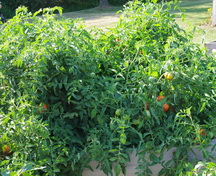 One of the most pleasant days we get to spend as garden writers in our little corner of the world is the Loblaw’s / Stokes’ tasting day. We wander down to the trial grounds at the Stokes Seeds’ farms and eat our way around the varieties on offer. The Loblaw’s stores, one of the largest grocery chains in Canada, runs promotions for its vegetable plant varieties in the spring. They are always looking for new varieties to feature in their Insider’s Report and they are foolish enough to assemble a group of garden writers to help them with their selections. The main feature of this group is their diversity of tastes and that makes the search for consensus on any new variety a very frustrating activity. This year we were given a preview of a thing called a “Mighty Mato.” Although not a particularly new idea in the growing of greenhouse Tomatoes, the introduction of grafted Tomato plants to the consumer market is a very new concept. These plants have standard and recognizable varieties of Tomatoes grafted onto a special rootstock that should greatly increase yield, earliness and size. One of these plants in your garden might be enough to supply all of your Tomato needs for next summer if you give it enough room to do its thing. I’m looking forward to trying one and am planning the 1 m sq (3 - 4 sq ft) of space it may require or the 1.7 m (8ft) tomato cage to accommodate it. After trying all of the varieties in the field and in a delightful lunch we finished with a wonderful local Peach Pie and a very sweet, small Melon that will probably be in the Loblaw’s program next spring. Did I mention the samples of the student’s work from the Niagara College wine makers course?
One of the most pleasant days we get to spend as garden writers in our little corner of the world is the Loblaw’s / Stokes’ tasting day. We wander down to the trial grounds at the Stokes Seeds’ farms and eat our way around the varieties on offer. The Loblaw’s stores, one of the largest grocery chains in Canada, runs promotions for its vegetable plant varieties in the spring. They are always looking for new varieties to feature in their Insider’s Report and they are foolish enough to assemble a group of garden writers to help them with their selections. The main feature of this group is their diversity of tastes and that makes the search for consensus on any new variety a very frustrating activity. This year we were given a preview of a thing called a “Mighty Mato.” Although not a particularly new idea in the growing of greenhouse Tomatoes, the introduction of grafted Tomato plants to the consumer market is a very new concept. These plants have standard and recognizable varieties of Tomatoes grafted onto a special rootstock that should greatly increase yield, earliness and size. One of these plants in your garden might be enough to supply all of your Tomato needs for next summer if you give it enough room to do its thing. I’m looking forward to trying one and am planning the 1 m sq (3 - 4 sq ft) of space it may require or the 1.7 m (8ft) tomato cage to accommodate it. After trying all of the varieties in the field and in a delightful lunch we finished with a wonderful local Peach Pie and a very sweet, small Melon that will probably be in the Loblaw’s program next spring. Did I mention the samples of the student’s work from the Niagara College wine makers course?Time to answer a few questions. If you have a gardening question just ‘reply’ to this newsletter and send me your query. I try to answer most of the questions and the ones that I answer here are those that I think will have the widest interest. You can also find the latest garden updates on the front page of gardening-enjoyed.com . |
| Back to Back Issues Page |
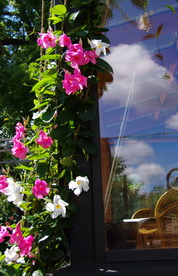 On a happier note, I’ve promised to keep reporting to you on things that I am trying. The Mandevilla that was set by the corner of the solarium and connected to the gutters above by some strings, has been a very successful experiment. It is in a self watering container so keeping it watered all summer was a bit easier and that allowed it to support the significant growth that this vine is capable of. We are now approaching the end of the summer and many of the vines have reached the top of the strings, providing us with a great display of their large pink and white flowers. They are visible from both the inside of the solarium and from the garden. There are two colours of flowers because there were two different varieties of Mandevilla planted in the container that came as another of the great trial plants from the Loblaw’s garden centres.
On a happier note, I’ve promised to keep reporting to you on things that I am trying. The Mandevilla that was set by the corner of the solarium and connected to the gutters above by some strings, has been a very successful experiment. It is in a self watering container so keeping it watered all summer was a bit easier and that allowed it to support the significant growth that this vine is capable of. We are now approaching the end of the summer and many of the vines have reached the top of the strings, providing us with a great display of their large pink and white flowers. They are visible from both the inside of the solarium and from the garden. There are two colours of flowers because there were two different varieties of Mandevilla planted in the container that came as another of the great trial plants from the Loblaw’s garden centres.